Exercise After Pregnancy: How to Get Back in Shape After Baby
Postpartum Abdominal Reconditioning: What’s Safe, What’s Not
So you’ve had your baby and now it’s time to do crunches, lots and lots of crunches, to get your abs back in shape again. Right? Well, actually no. Fitness and exercise after pregnancy is a lot more complicated than that. In fact, exercises like crunches actually do more harm than good in the initial postpartum period.
To appreciate the subtleties of exercise after pregnancy and particularly postpartum abdominal reconditioning, it’s helpful have a basic understanding of the structure and functions of your abdominal wall.
Postpartum Fitness and Exercise: Abdominal Wall Structure and Functions
The abdominal wall is comprised of four main pairs of muscle tissue, each with right and left sides, which cover and support the abdominal cavity.
Muscle Layers of the Abdomen:
The Rectus abdominis
 Nicknamed the “six pack”, the Rectus abdominis runs vertically from the sternum to the pubic bone. Its primary job is spine Flexion , particularly in the supine position. Exercises like crunches flex the upper spine, which move the ribcage closer to pelvis. Pelvic tilts and reverse rolls flex the lower spine, which move the pelvis closer to the ribcage.
Nicknamed the “six pack”, the Rectus abdominis runs vertically from the sternum to the pubic bone. Its primary job is spine Flexion , particularly in the supine position. Exercises like crunches flex the upper spine, which move the ribcage closer to pelvis. Pelvic tilts and reverse rolls flex the lower spine, which move the pelvis closer to the ribcage.
A narrow band of connective tissue (the Linea Alba ) runs down the body’s midline between the Rectus abdominis. During pregnancy, the Linea Alba widens and becomes thinner in response to hormones and the force of expanding uterus .
Abdominal separation, (diastasis recti) a fairly common occurrence during the latter part of pregnancy and the postpartum period, causes the right and left sides of the Rectus abdominis to separate along the Linea Alba . (See the Diastasis Recti page of this web site for more details.)
The External oblique and Internal oblique
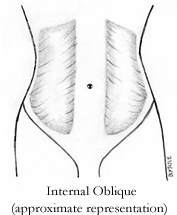
 The External oblique is the most exterior layer of the abdominal wall and runs diagonally from the ribs toward the midline. The Internal oblique lies underneath the External oblique and has diagonal fibers that run in the opposite direction. Together, they form an X shape across your torso. You can think of the top half of the X as the External oblique and the bottom half of the X as the Internal oblique . These two muscles always work together and perform Lateral spine Flexion (side bends) and assist in spine rotation.
The External oblique is the most exterior layer of the abdominal wall and runs diagonally from the ribs toward the midline. The Internal oblique lies underneath the External oblique and has diagonal fibers that run in the opposite direction. Together, they form an X shape across your torso. You can think of the top half of the X as the External oblique and the bottom half of the X as the Internal oblique . These two muscles always work together and perform Lateral spine Flexion (side bends) and assist in spine rotation.
The Transverse abdominis
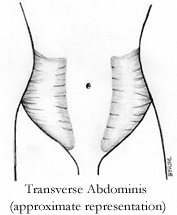 The deepest layer of the abdominal wall, and the most important in postpartum exercise, is the Transverse abdominis. It’s fibers run across the abdomen and performs abdominal compression, which draws the belly inward, and narrows the waist. Fitness trainers refer to this muscle as the body’s “internal girdle.” Interestingly, unlike most skeletal muscles, the Transverse abdominis does not move bone.
The deepest layer of the abdominal wall, and the most important in postpartum exercise, is the Transverse abdominis. It’s fibers run across the abdomen and performs abdominal compression, which draws the belly inward, and narrows the waist. Fitness trainers refer to this muscle as the body’s “internal girdle.” Interestingly, unlike most skeletal muscles, the Transverse abdominis does not move bone.
After pregnancy, contraction of the Transverse abdominis acts like an internal splint, helping to close abdominal separation from the inside. It’s the body’s most important core stabilizer and is responsible for re-flattening the abdominal wall after pregnancy.
As you’ll see below, the first step in exercise after pregnancy and rebuilding the abdominal wall is the development of strength and functional control in the Transverse abdominis.
Exercise After Pregnancy/Postpartum Fitness: Post Natal Abdominal Reconditioning
Two main concepts must be understood and utilized to quickly, safely, and effectively strengthen and flatten your abdominal wall after pregnancy.
First, a critical component for restoring your abs and the development of core strength is learning to control the shape of your abdominal wall during exercise. To do this, you need to train your abs to pull back in toward your spine during exertion. The quickest and safest way to develop a flat abdominal wall after pregnancy is to perform special postpartum exercises that specifically develop this essential skill.
Second, dynamic stability is the other key component of postpartum reconditioning and exercise after pregnancy. This term may sound like a contradiction. However, it refers to the ability to maintain proper position during exercise. Because you have both loose joints and weakened abs after pregnancy, it is particularly easy for the weight and force of your limbs to pull your pelvis, spine, or shoulder girdle out of good alignment. When your bones are out of proper positioning, muscle functioning is impaired, which greatly reduces the effectiveness of exercise. After pregnancy, you must learn to recognize and eliminate undesired movement during exercise. dynamic stability is an essential skill that enables you to develop core strength, promotes healthy spinal function, and prevents injury.
For more on how pregnancy affects muscles and joints please consult the Physiological Adaptations During Pregnancy and Pregnancy and Postpartum Discomforts pages of this web site.

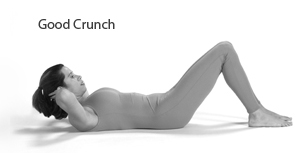
Exercise After Pregnancy/Postpartum Exercise: The REAL Secret to Flat Abs
The real secret to flattening the abdominal wall after pregnancy is to recondition from the inside out. This is done by first building strength, and then functional control, in the deepest abdominal muscle, the Transverse abdominis or TvA. You want to avoid starting reconditioning with traditional exercises like crunches and oblique curls, which strengthen the external layers, the Rectus abdominis and the External oblique . After pregnancy it’s all too easy for these external layers to overpower relatively weaker TvA. This causes the abdominal wall to bulge outward during exertion.
Notice the difference in the shape of the abdomen. The model here is almost 7 mos. postpartum, and her abdominal wall has already shortened and firmed up quite a bit. The ballooning of the abdomen is much more pronounced for those with more abdominal laxity.
In sports and fitness training, what you practice is what you get, i.e., muscle specificity theory. If you allow the abs to balloon during exercise, that is what you are unintentionally training your abs to do. (Yikes!) More importantly, expansion of the abdominal wall worsens abdominal separation and contributes to many postpartum problems, such as lower back pain, pelvic instability, postural problems, and urinary stress incontinence.
Lack of strength and functional control in the TvA is the most common pitfall for all new moms. Most women, who have tried to recondition their abs the traditional way, with lots of crunches, end up with unsatisfactory results. Their abs grow stronger, but never flatten. Their bellies, particularly below the waist, protrude and stay round.
Postpartum Exercise/Postnatal Fitness: Functional Imbalances from Improper Exercise After Pregnancy
Routinely exercising the external muscles while neglecting the deepest layer results in a functional imbalance within the abdominal wall. Poor neuromuscular patterning results, which inhibits the development of dynamic stability and core strength. This sets the stage for many types of back problems, and is a clear example of how form follows function in the body.
Exercise After Pregnancy/Postpartum Exercise: Impacts on Spinal Alignment and Postnatal Posture
As you now know, reliance on supine (on the back) abdominal exercises that flex the upper spine, including most traditional abdominal exercises, many Pilates mat exercises, and some yoga poses, should be avoided immediately after pregnancy. In postpartum women, the curve of the upper back has increased significantly; a kyphotic posture, (see the Physiological Adaptation During Pregnancy page of this web site) . This is why so many new moms feel “hunched over” after childbirth. Habitually performing exercises that flex the upper spine aggravates the problem. It is far better for new moms to focus on lower spine Flexion , which improves pelvic alignment, and to perform abdominal exercises where the upper spine is stabilized in the neutral neutral position.
Exercise After Pregnancy/Postpartum Workouts: How to Get the Best Results
The safest, fastest, and most effective way for you to whittle your waist and develop a nice hour-glass shape into your torso, is to start postpartum exercises and abdominal reconditioning with exercises that isolate and strengthen your TvA. After this muscle has become strong again, you can then progressively add in exercises that work external layers, all the while maintaining a flat abdominal profile. Using this method, you will not only flatten and re-Tone your abs, but just as importantly, you will train all four layers of the abdominal wall to function synergistically.
Exercise After Pregnancy/Postpartum Exercise: Even if You’re Post Postpartum, It’s Never too Late to Correct a Problem
Don’t panic if you’ve had a baby in the last year (or even longer) and have been consistently “crunching” your external abdominals. It’s never too late to retrain your abs from the inside out. With the right exercises in the right order, you can teach yourself this important skill and make significant improvements in the shape of your abdomen that will take inches off your waistline.

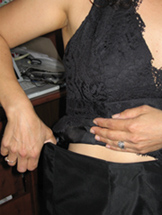
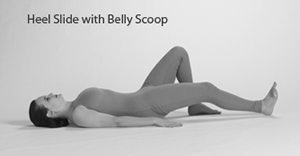 You’ll also learn a series of unique and powerful postpartum fitness techniques that I created after my son was born, and then went on to refine in my many years of teaching postnatal fitness classes. Techniques that you’ll only find in BeFit-Mom programming. Here’s an example of one of my special postpartum exercises.
You’ll also learn a series of unique and powerful postpartum fitness techniques that I created after my son was born, and then went on to refine in my many years of teaching postnatal fitness classes. Techniques that you’ll only find in BeFit-Mom programming. Here’s an example of one of my special postpartum exercises.